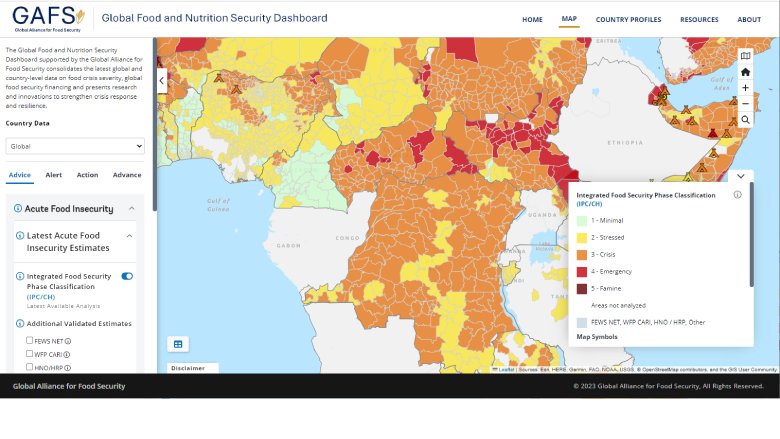The Global Food and Nutrition Security Dashboard enables humanitarian and development agencies along with governments to quickly get an overview of the food and nutrition insecurity situation worldwide. It assists countries’ crisis preparedness while helping them collectively respond where the need is greatest. One year after its launch in November 2022, the Dashboard has evolved into the ultimate resource for immediate and critical data to address pressing needs.
Produced by the Global Alliance for Food Security (GAFS), co-convened by the World Bank and the German G7 Presidency, the Dashboard marks an historic leap forward, offering a comprehensive and transparent understanding of food and nutrition data from a wide range of global, national, and sub-national sources. Thanks to the World Bank and GAFS’s global convening power, the Dashboard provides an international platform for responding to food crises. It enables governments, international financial organizations, and the aid community to share knowledge from over 40 GAFS partners, leveraging the resources of multilateral and bilateral organizations.
“What’s really amazing about the dashboard is what it does at the country level,” said Julian Lampietti, World Bank Manager for Global Engagement, in the Agriculture and Food Global Practice. “It helps defragment the donor effort by bringing everyone into a single space to share information, and then allows the government to be looking at all the information with all of the donors at one time, so everyone has the same understanding.”
There are many tools on different platforms aimed at collecting and explaining different aspects of food and nutrition security, making it challenging to effectively navigate the available data. The Dashboard has transformed that task.
“The GAFS Dashboard has promoted collaboration and knowledge-sharing among various stakeholders involved in the food security data space,” said Sara McHattie, Global Coordinator for the Food Security Information Network. “By providing a one-stop of the latest information on food security and nutrition from diverse sources, the GAFS Dashboard has not only made data more accessible but has also amplified the visibility of crucial information, including the data of the Global Report on Food Crises - ensuring that acute food insecurity receives the attention it deserves from decision-makers.”
The Dashboard is accessible to anyone with an internet connection. It enables users to track up-to-date information on a purposefully selected set of about 25 key food and nutrition security indicators, such as the number of people experiencing acute or chronic food insecurity, or malnutrition and wasting, at various levels of analysis. It also provides up-to-date information on food security financing and showcases research and innovations for crisis response and long-term resilience.
“Supporting the GAFS partners to use openly published data by a wide variety of donors and implementing agencies using the International Aid Transparency Initiative (IATI) standard has been very engaging,” said Steven Flower, from the IATI Secretariat, which was conceived to assure that policy decisions are informed by data. “The use case of GAFS shines a light and amplifies this significantly.”
“So far, we've instigated a specific method to search and use IATI data, which has been informed by policy experts at the FAO. We're very keen to further support GAFS and its partners to be more precise within their IATI data publications.”
According to the Global Donor Platform for Rural Development, 78% of all aid for agriculture in 2018 was bilateral, comprised of 13,649 activities with an average funding of $500,000. In such a fragmented landscape of overseas development, the Dashboard can help coordinate financing to achieve SDG-2 of zero hunger by 2030. It will also support the World Bank’s efforts to address food and nutrition security which is among the eight global challenges that the Bank will tackle at scale.
One crucial aspect of the Dashboard is its ability to reduce transaction costs, improving program efficiency to ensure that aid reaches beneficiaries more easily, and at lower cost. This supports the ability of governments, policy makers, international agencies, and donors to improve coordinated responses to future global food crises, building upon existing knowledge and responses rather than starting from scratch when a new challenge arises.

